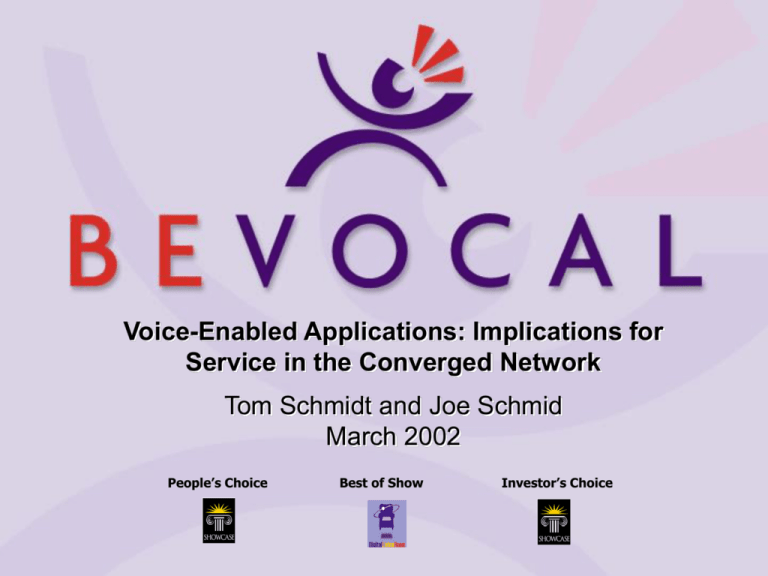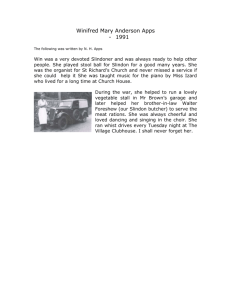ppt - BNRG
advertisement

Voice-Enabled Applications: Implications for Service in the Converged Network Tom Schmidt and Joe Schmid March 2002 People’s Choice Best of Show Investor’s Choice Agenda Introductions. Brief company overview. (We’re not in sales!) Technology trends. Where does the value in tomorrow’s “perfect” network reside? Examples of decomposing today’s Voice Applications. BeVocal’s value proposition. Challenges of creating a voice services framework in a converged world. 2 Why does BeVocal exist? Improvement in speech reco. Commodity, standard hardware platform availability. Internet model of standard software platforms and interfaces. (VoiceXML, HTTP,etc.) 3 Why NOT the Internet model for voice? Stability QoS No clear billing/revenue model Very different expense points and models User experience requirements/expectations Heavily regulated Sloth-like carrier movement 4 About BeVocal Founded in March 1999, based in Santa Clara, CA Headcount – 100+ Raised $70M in venture funding to date – Mayfield Fund, US Venture Partners, Technology Crossover Ventures, Trans Cosmos USA, prominent angel investors Launched BeVocal consumer service offering in June 2000. Carrier-focused with proven in-network deployments with tier-1 carriers: BellSouth, Cingular, Qwest. 5 What we do Your network is your biggest asset. BeVocal’s voice software helps you generate more money from your network, by delivering more value and creating a better experience for your customers. 6 Delivering bottom-line results to carriers Enhanced voice services enable telecom companies to Achieve 10-25% increase in subscriber revenues by – capturing additional monthly subscription fees of $5-10/sub/month – up-selling subscribers to premium bundles – attracting new subscribers via unique, differentiated offerings – improving customer loyalty with highly personalized, branded services Achieve 30-40% decrease in service costs by – automating call centers for customer support and directory assistance – consolidating voice applications onto an open, flexible voice platform 7 Delivering value to consumers and businesses Simply by speaking, callers can instantly connect to people, businesses, and information from any phone Enhanced voice services include: – Voice Dialing – dial by saying a number or name in your address book – Voice E-mail – read and reply to e-mail messages via phone – Voice Mail – play and send messages using voice instead of a keypad – Voice Portals – access the best of the web over the phone location and travel services (driving directions, business finder, weather, traffic, and flight info) information services (stock quotes, news, sports) entertainment services (movies, TV dramas, horoscopes, lottery) – and much more … 8 Delivering enhanced services in a new way Low risk deployments with fast time to market in a cost-effective and scalable manner. • • Vendor-independent technologies based on open standards (VoiceXML) Incremental, pay-as-you-grow build-outs • Assets reusable across business units • Assets reusable across products • Services created and designed by carriers and third-party developers Make your network more valuable in helping to defend and grow market share in the face of competitive and regulatory challenges. 9 Proven deployments with network operators Wireless carrier customers Wireline carrier customers Telematics service provider customers 10 Major Trend in Telecom Networks – Stupidity 1997 David Isenberg (at AT&T) writes “The Rise of the Stupid Network” comparing the network models of the PSTN and the Internet. PSTN model: – Intelligence embedded in the middle of the network. (AIN) – Assumes circuit switched voice is the bulk of traffic. – Assumes of scarcity of computing resources. – Centralized control. Internet model: – “Dumb” transport in the middle. – Pushes intelligence to endpoints. (Prof. Katz’s “Hourglass” diagram.) – Smart endpoints drive the network, not limited by design assumptions of the network itself. Many implications to each model, primarily centered around innovation. Stupid network likely to “win” in the end, but continued coexistence is likely for some time. 11 Characteristic of Two New Protocols – Stupidity SIP and SOAP embrace the model of “dumb” transport by: – Standardizing basic protocol plumbing, but… – Allowing for extensible headers, opening up… – The ability to layer additional services on top of this basic plumbing. – Again, intelligence has been pushed to the endpoints. Extensibility examples: – Standards for IM and Presence (SIP for Instant Messaging and Presence Leveraging Extensions – SIMPLE WG) already being layered over basic protocol as extensions in SIP headers. – Security, Digital Signatures (W3C SOAP Note) already being layered over basic protocol as extensions in SOAP headers. – Nothing violated or changed in basic protocols. – Intermediaries (SIP Proxies, SOAP Intermediaries) can process messages regardless of extended headers. 12 A Key Question “Where is the edge of the network?” – In today’s PSTN? – In today’s WAP-enabled wireless networks? – In today’s TCP/IP internets? – In tomorrow’s (today in some places…) 3G wireless networks? – Answer is dictated in part by where new services can be added. Likely answer will be… – Edge of the network is on my intelligent wireless devices – with always on, high-bandwidth packet network wireless connectivity. In evaluating evolving network designs, try to identify “edge” of the network. 13 Network edges – VoiceXML vs. SALT VoiceXML (http://www.voicexml.org) – Brings the web model (HTTP + standard mark-up) to voice services, but… – Still embraces the PSTN-style “intelligence in the network” model, rendering audio UI (VUI) onto dumb terminal phones. – Both evolutionary and revolutionary. Fits into existing telecom networks, but opens up service creation by using web model. SALT (http://www.saltforum.org) – Mark-up standard for specifying true multi-modal, interruptible interaction with users. – Accounts for PSTN-style, voice-only deployment scenarios, but… – Big win is when SALT interpreter executes on intelligent devices. Back to intelligent endpoints model. – Allows innovation on endpoints – intelligent devices + backend services. 14 The Network Paradox (http://netparadox.com) "The perfect network is perfectly plain, and perfectly extensible. That means it is also the perfect capital repellant, [which] implies a guaranteed loss to network operators, but a boon to the services on the 'ends'." -- Roxanne Googin in the September 2001 issue of her “High Tech Observer” report. “Perfect” in terms of: – Delivering bits in large quantities, at high rates. – Open to new, innovative services at the endpoints. 15 Decomposing Monolithic Voice Services Today’s Voicemail: – Sits as “intelligent peripheral” on the SS7 network. – Delivers many functions in one monolithic black box: Renders UI onto device – today’s “dumb terminal” 64kbs audioonly phones. Contains UI logic, controls user interaction. Message store. Decomposition under way from an unlikely source – Microsoft: – .NET My Services moves “message store” into network cloud. – Available anywhere, anytime, on any device. – Decomposed model looks very different, very flexible. – Who owns the billing relationship? Keep an eye on this one… 16 Another decomposed example: VAD Voice Activated Dialing where: – Subscriber can provision phone to use any provider of Voice Activated Dialing on the network. – Subscriber’s personal/business Contacts loaded by VAD application from web service. – After recognizing destination party, uses Presence web service to detect location of called party, intelligently routing call or offering options to caller. Implications: – Applications become more like “assemblies of services” rather than monolithic black boxes. – Framework for assembling services is needed (and valuable). – QoS, SLAs, response latency become critical among these decomposed pieces. Side Note: One off-the-wall prediction about the LNP equivalent in the consumer-oriented web services world! 17 BeVocal’s Value Proposition Provide a software platform that allows creation, deployment, and management of innovative voice [and multi-modal] services on a large scale. (Think BEA WebLogic for voice/multi-modal apps.) Requirements of such a platform: – Enable “assemblies of services.” – Event-driven, interruptible. – Scalable, fault-tolerant, etc. – Does the “heavy lifting” of building innovative apps. 18 BeVocal Foundation Platform (Part One) Addresses common problems of building voice apps: – Prompt and grammar management. – Dialog flow, templates, building blocks. – “Universals”, context sensitive help. – Versioning. – “Hot” deployment and upgrade (across sites). – Application health and monitoring. – Usage and performance statistics. – Assembling combinations of apps (“portlets”) into “portals”. 19 BeVocal Foundation Platform (Part Two) Offers compelling services needed to build carrier-grade voice applications: – Alarming and monitoring. – Flexible billing infrastructure. – User Profile and Personalization. – Address Book. – Content Feeds. (Weather, Traffic, Sports, etc.) – Security (Authentication and Authorization). – Service Discovery and Registration. – Distributed, real-time session data. 20 Enabling Unique Multi-Modal Applications When fully deployed, (SIP-enabled smart endpoints) SIP will open up a variety of innovative applications. BeVocal’s Platform should be prepared to take advantage of these unique abilities once available: – Not everything is a phone call! Use generic “trigger” concept. – Build “interruptability” into service creation environment and make it easy. – Support distributed, shared session state. – Account for multiple “legs” of sessions (conferencing, chat, etc.) – Account for “long running” sessions. (e.g. Notification of bid status on eBay, etc.) 21 Challenges Design and implement an architecture that: – Fulfills today’s needs for creating, deploying, and managing voice services in a carrier environment. – Makes it easy for third party developers to create a variety of apps. – Allows for compelling services provided both by BeVocal and “assembled” from third parties. – Will deliver on tomorrow’s opportunity to easily develop interesting multi-modal applications. – All done in a way that is manageable and costeffective on a carrier-size scale, with performance that meets mass-market criteria. 22 Q&A Thank you for having us! 23







